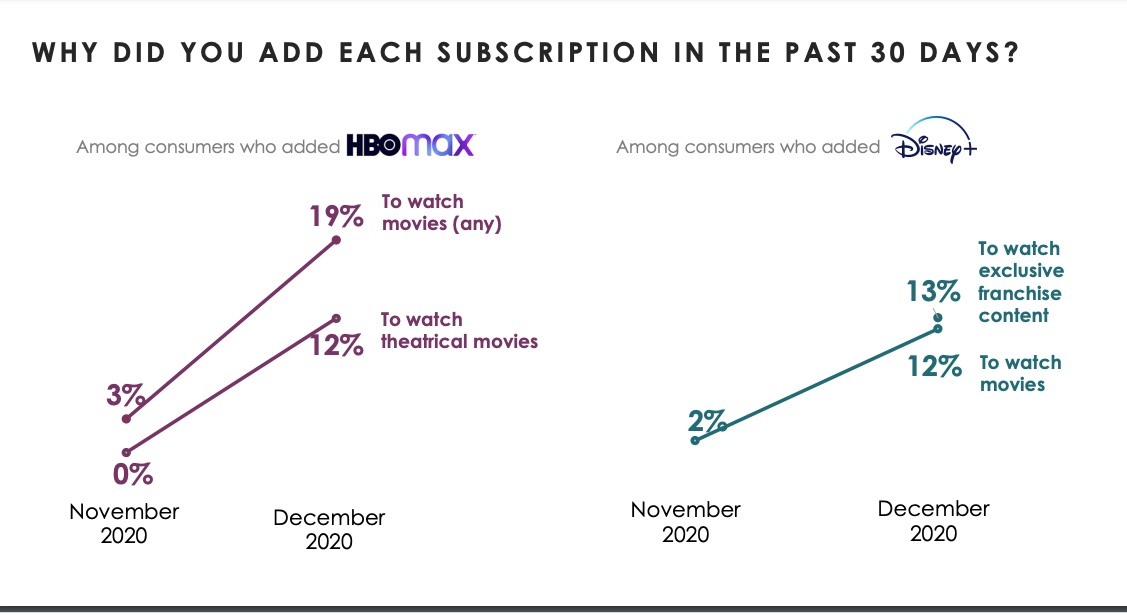Disney, WarnerMedia, Discovery, et al. Fixate on Subscriber Counts, But the Bottom Line Begins to Toll
Or, why you can expect those monthly SVOD prices to go up real soon

The streaming business is about to get a lot more expensive, if early signs of subscriber interest in premium content on HBO Max and Disney Plus force competitors to ante up to attract and keep subscribers.
The question is, can the legacy media companies spend enough on streaming content to keep pace with Netflix’s global audience and the near-bottomless wallets of Apple and Amazon. That doesn’t even include the world’s most valuable connected-TV service, Alphabet-owned YouTube, which is absorbing more and more TV ad dollars and doesn’t even pay for programming.
WarnerMedia turned Hollywood upside down in December when it announced it would release Wonder Woman 1984 and its entire 2021 theatrical film slate simultaneously on HBO Max and in whatever’s left of the theater business.
Days later, Disney executives told investors the company would be doubling its entertainment spending to $8 billion a year, with 80% of the resulting series and features headed straight to streaming. Series and features from the company’s crown jewels—Pixar, Star Wars and Marvel—are a key part of the streaming mix.
Hub Entertainment Research just released data from its year-round Hub TV Churn Index surveys suggesting both announcements had a big impact on consumers who signed up for Disney Plus and HBO Max. In both cases, high-profile content became a significant reason why subscribers signed on in December.

That’s particularly good news for HBO Max, which had a shambolic launch in the spring, forcing new WarnerMedia chief Jason Kilar to spend the summer and fall cleaning house, reorganizing old content silos, fixing carriage fights, and zapping confusingly named legacy apps.
HBO Max—whose content production remains hobbled by the pandemic—now has a powerful differentiator, especially if it keeps the day-and-date release strategy after 2021, as some predict.
NEXT TV NEWSLETTER
The smarter way to stay on top of the streaming and OTT industry. Sign up below.
“It was not ideal how (HBO Max) was launched, and then at $14.99 (a month), it was a lot higher than other services out there,” said David Heger, a senior equity analyst with Edward Jones in St. Louis. “Putting movies on HBO Max, all of a sudden they have something they can market. It helped give the service a little more recognition.”
Both HBO Max and Disney are leaning hard into streaming marketing with pricey ad campaigns highlighting high-end programming. All Kilar’s work is starting to pay off, too. HBO Max subscribers doubled in the fourth quarter to 17.7 million, and the combined HBO Max/HBO cable universe has 39 million customers, executives said during AT&T’s recent earnings call. The competition no doubt has noticed.
“Some of the other streaming players are going to be looking at how to have more movies available, especially first run,” Heger said. “It’s going to be interesting to see after the first year if this going to be a model ongoing. (WarnerMedia) might step back to the Disney approach, where tentpole movies go to theaters first before hitting online. Beyond tentpoles, it may make sense to release (smaller films) directly to SVOD or do (day and date).”
Movies likely won’t be the only place where services are trying to differentiate themselves. Industry trade publications spent much of last week pondering the push for children’s programming, which Disney Plus has shown can be reliably sticky for the millions of households with harried WFH/SFH families.
Former Pixar and Disney animation chief John Lassiter is now running Apple’s animation productions, while HBO Max is gathering its prodigious animation assets, which include Looney Toons, Cartoon Network, Adult Swim, anime, and the sublime work of Japan’s Studio Ghibli. Paramount Plus will certainly be pitching its decades of Nickelodeon franchises on Wednesday.
Even live news, traditionally a prestige money-loser, has become hot. Tubi just announced that it’s pushing further into live news, adding dozens of local broadcast affiliates’ feeds, while Sinclair’s STIRR service counts on local news from its dozens of broadcast affiliates as a major differentiator.
Now we’ll start to hear from everyone else. Apple’s annual shareholder meeting is Tuesday morning, and that might be the place for the world’s most valuable company to talk more about its video plans.
But the company has said little in previous quarterly earnings calls and product announcements about TV Plus, beyond noting it’s an attractive component of new Apple One subscription bundles and the company’s giant “Services” segment, which generated $15.6 billion in the holiday quarter.
Also this week, we’ll hear from ViacomCBS about its plans for Paramount Plus, which launches March 4 on the underwhelming bones of CBS All Access. ViacomCBS says it will detail its “free, pay and premium streaming strategy,” which also includes broadcaster CBS, its bevy of classic pay-TV networks, Paramount Studios, and free, ad-supported Pluto TV.
We’ve already heard from Discovery, which held an upbeat, some would say relieved, earnings call first thing Monday morning.
Discovery CEO and President David Zaslav said the basic-cable stalwart will end stock buybacks this year, while creating 1,000 hours of new Discovery Plus originals.
Of note, Discovery plans to continue making new shows for its existing linear TV empire, an opportunity to remain a valuable component of the fading pay-TV bundle while other media companies largely abandon original shows there.
That combined approach, Zaslav and CFO Gunnar Wiedenfels said, will make Discovery’s outlets a go-to not just for streaming fans or the large remaining audience that hasn’t cut the cord, but also for advertisers looking to connect on both platforms (Discovery Plus offers a $4.99 tier with ads).
The result, Wiedenfels said, is a chance to build a sturdy domestic presence online and off going forward, instead of just relying on overseas opportunities for growth.
“I like the sound of that,” Wiedenfels said. “Candidly, it's been a while since we've had a positive (forecast in the domestic market).”
But integrating new streaming ventures with declining legacy platforms is the key issue facing the big media companies, according to a recent post by analysts Rich Greenfield, Brandon Ross, and Mark Kelley of LightShed Partners about the companies’ “leaky bucket.”
LightShed’s big question: When will investors start caring less about subscriber numbers and more about other key metrics, such as average revenue per user, or ARPU? And how do the media companies with broadcast and cable operations make a soft landing with those legacy properties while still investing heavily in their streaming futures to keep up with digital powers?
“There is no dabbling in streaming and it is a scale game that requires massive investment to attain success,” LightShed wrote. “Oddly, investors have thus far completely ignored the TAM of each service, the long-term potential ARPU and most importantly, how profitable the services could ultimately be.”
Add in that aggressive streaming investments will only hasten the decline of the legacy audiences and advertising, the LightShed post says, and “When taken together, these companies do not have a bright future.”
There are lots of reasons to be optimistic about streaming’s long-term future, given its global economies of scale, opportunity for deep data-rich understanding about audiences, and efficient marketing opportunities.
But getting to profitability between now and that faraway time won’t be easy for most legacy companies, LightShed argued. Sooner or later, investors who’ve been overly focused on that subscriber top-line number may start looking lower, to the bottom line.
“We have no doubt that new/recent streaming services should all be able to add 5-6 million subscribers in 2021 domestically, if not more,” the analysts wrote. “That may be enough to continue short-term investor enthusiasm for the entire sector. However, the far more important question is can they continue to add 5-6 million subs per year, let alone 7-8 million, if cord-cutting accelerates as linear TV reduces content spend to manage profitability?
Legacy media companies are beginning to understand the cost of doing business on a global, direct-to-consumer platform. Soon enough, investors will understand it too. And that’s where the earnings calls and investor days are going to get really interesting.
David Bloom of Words & Deeds Media is a Santa Monica, Calif.-based writer, podcaster, and consultant focused on the transformative collision of technology, media and entertainment. Bloom is a senior contributor to numerous publications, and producer/host of the Bloom in Tech podcast. He has taught digital media at USC School of Cinematic Arts, and guest lectures regularly at numerous other universities. Bloom formerly worked for Variety, Deadline, Red Herring, and the Los Angeles Daily News, among other publications; was VP of corporate communications at MGM; and was associate dean and chief communications officer at the USC Marshall School of Business. Bloom graduated with honors from the University of Missouri School of Journalism.

